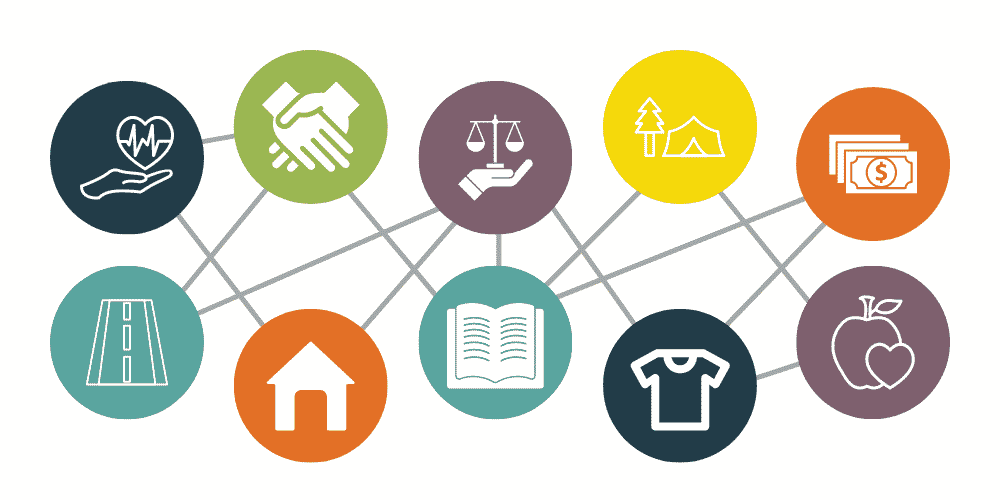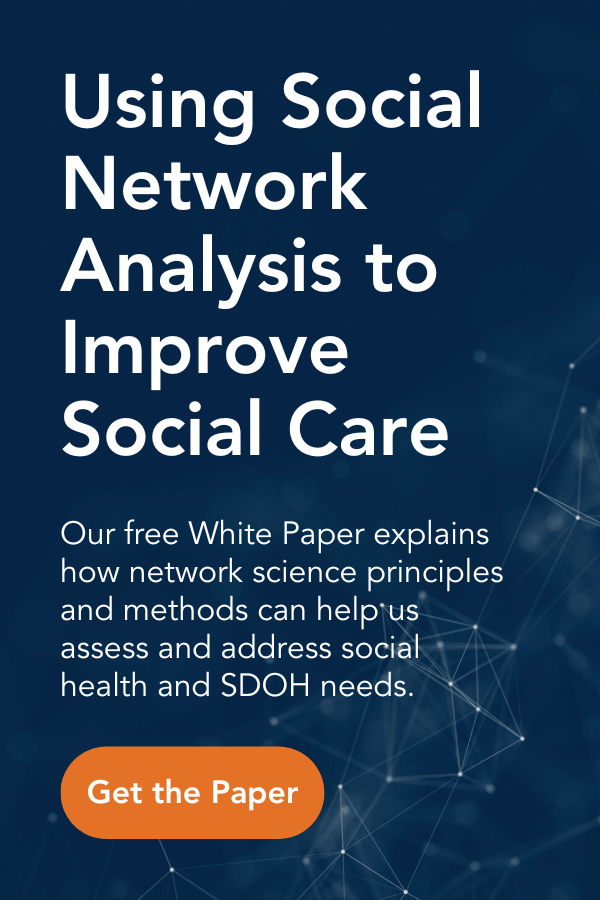What Are the Social Determinants of Health?

Only 10-20% of our health outcomes are determined by what happens in a medical clinic.
You read that right. Just 10-20%!
The other 80-90% results from our health behaviors, where we live, and other factors like access to housing, food, and social support. We call these the social determinants of health: factors about how we live, work and play that, directly and indirectly, impact our health and well-being. In this blog, we will answer the question, “What are the social determinants of health?” We will also explain why they are so important and how we are helping address them here at Visible Network Labs.
What are the Social Determinants of Health?
As stated above, the social determinants of health are wide-ranging, including places and environments (pollution, access to parks), health-related behaviors (tobacco use and risky behavior), and other social resources (access to food, shelter, and employment). Together they have a much more significant overall impact on health outcomes than medical care. Even with top-notch medical treatment, someone without access to suitable housing or lacking a solid support network cannot reach their full care potential.
This list illustrates the range and diverse types of social determinants of health. It is not an exhaustive list of all the social determinants. Read our recommended resources further down for a few sites with a complete SDOH framework and categorizations.
SDOH 1: Housing
Numerous studies have established a strong link between homelessness or housing instability and adverse health outcomes. For example, The average life span for a homeless person is between 42 and 52 years – nearly 30 years shorter than an average American. While numerous causal mechanisms exist, the most common include the stability of homes, safety, and financial security that comes with affordable housing.
SDOH 2: Transportation
Transportation serves a critical role for patients, linking them to doctor visits, helping them pick up prescriptions and other goods necessary for their health. Yet every year, 3.6 million people in the United States do not obtain medical care due to transportation issues. Providing greater public transportation and using telehealth where appropriate can help bridge this gap to improve health and well-being.
SDOH 3: Legal Support
Oftentimes, people lack access to affordable legal support, which adversely impacts their health behavior and resources. Research has found that most impoverished people have 2-3 different unmet legal needs. Those facing ill-treatment, scams, or discrimination are unable to find redress. Studies suggest that programs like Medicaid-Legal Aid partnerships can dramatically improve health outcomes, especially in pediatric environments.
SDOH 4: Food and Nutrition
Good nutrition is a foundation for lifelong health and wellness. Research has consistently demonstrated that food insecurity has a significant adverse impact on health outcomes. For example, studies found that food-insecure children are at least twice as likely to report being in fair or poor health and at least 1.4 times more likely to have asthma than food-secure children. Helping families develop long-term, dependable access to nutritious food is an important way to improve on the social determinants of health.
SDOH 5: Employment
The link between employment and health outcomes may not be as significant as other social determinants, but it is undoubtedly there. Unemployment is explicitly associated with severe mental health challenges. Examples of adverse health outcomes related to unemployment include increases in depression, anxiety, mixed symptoms of distress, and low self-esteem. Because of the relationship between health insurance and employment, getting a job usually also increases affordable access to healthcare.
SDOH 6: Social Connectedness
Our relationships with others and the support they provide us is a critical social determinant of health. They support health in three different ways. First, our connections influence health behaviors and connect us to opportunities and resources. Second, they influence us psychosocially, providing emotional support, self-esteem, and a sense of belonging. Third, there is a direct physiological impact, as time spent with others boosts cardiovascular and immune system function.
SDOH 7: Environment
Where we live has a significant effect on how long we live. Environmental pollution, community resources, and social ties in your neighborhood all influence your health and well-being. Studies show that your zip code is a better predictor of your health outcomes and life expectancy than your genetic code. This tool from the Robert Wood Johnson Foundation allows you to compare life expectancies in your neighborhood to state and national averages. The differences can be shocking!
SDOH 8: Education
Education is a transformational life experience, providing access to new ways of living, thinking, and working. Education is a significant pathway to boosting your earnings; it helps you live healthier, eat better food, and get better quality healthcare. This link is why in 2008, the life expectancy gap between the most and least educated Americans grew from 13 to 14 years among males and from 8 to 10 years among females. Giving people access to a high-quality education clearly changes their health and well-being for the better.
SDOH 9: Technology and Internet Access
Technology is a significant factor when it comes to accessing healthcare, resources, and other information. As the COVID-19 pandemic struck and telehealth services exploded in use, patients without access to broadband internet, especially marginalized communities and rural areas, were at a significant disadvantage when it came to accessing care. However, they also find it harder to access social services, research health-related information, or access social and work opportunities, leading to worse health outcomes.
Social Connectedness is a Key Determinant of Health
While all the social determinants of health are essential, social connectedness is a critical factor, as it can positively influence most other determinants. Someone who lacks access to food and housing but has a solid social support network is likely to find resources and help independently. Numerous studies show that people prefer to leverage their network for assistance before turning to systems-level support at a community level. Thus, by assisting people in building more robust, higher-quality social connections, we can improve access to food, housing, education, and most other social determinants of health.
We're Building Tools to Identify SDOH Need Gaps and Fill Them
We are helping providers use a social connectedness approach to address the social determinants of health. Using a strength-based approach and social network analysis, PARTNERme identifies an individual’s unmet social needs, along with their support network. The tool allows providers to quickly identify support gaps and share targeted community referrals to fill them. It creates actionable insight into patient support outside the clinic to allow for better care coordination. Click here to learn more about PARTNERme.
What are the Social Determinants of Health? Now You Know!
As you can see, it is not easy to answer the question, ‘what are the social determinants of health?’ The list of factors that affect our health is long and constantly growing as the world becomes more complex. The essential idea is to shift your perspective from viewing health as the sole result of medical care. Instead, be open to the variety of ways that the way we live, work, learn, and play affects our health and well-being. Using a systems thinking lens that considers direct and indirect causes, feedback loops, and other dynamics can help you build better solutions to improve health and well-being. That’s our goal with PARTNERme.
More SDOH Resources
Are you looking for more detailed information about the social determinants of health? Here is a good list of resources with some of our team’s favorite articles and blogs on the subject. If you have a suggestion for additional resources we should add, please share it below in a comment or send it to us via our contact us page. We hope we helped answer your question, “what are the social determinants of health?”

About the Author: Alex Derr, M.P.A.
Director of Marketing & Communications
Alex joined VNL in 2017, originally supporting our events. He now helps manages our communications and marketing strategy and content development work. Alex creates blogs, infographics, reports, and other content while managing our web and social media presence. He also runs our email marketing campaigns, tracks analytics, and conducts market research to drive our strategy. He supports our entire team with copywriting, graphic design and research, and helps with events, webinars, demos, and other online learning. When he isn’t at work Alex spends his time climbing 14ers (30 done, 28 to go!) and blogging on his own website, The Next Summit Blog.
|
|
Thank you for Signing Up |

More Social Care Resources




